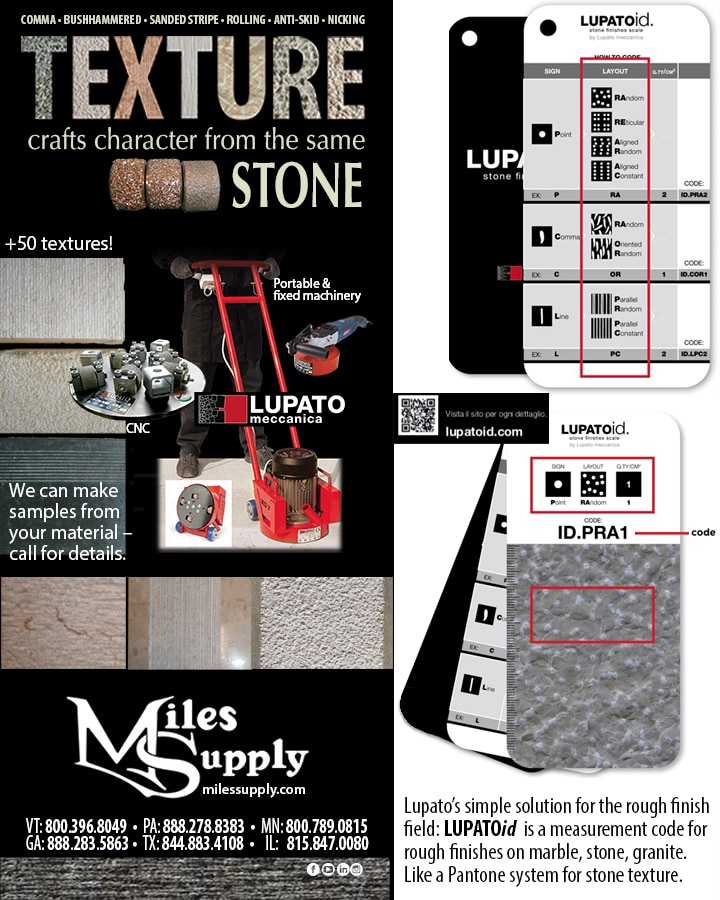LupatoID helps codify the rough finish that you want on your stone. Texture is another surface or finish that changes the look of a stone, even the same stone can take on a completely different character.

On LupatoID.com you will find codes for finishes that can be made on the surfaces of many kinds of slabs: natural stone, marble, stone, granite or agglomerates. And on Lupato’s website you can click on a texture you like and it will bring up the tool that made it. See more about Lupato or request a quote.
While a polished finished enhances the characteristics of the stone material, highlighting its natural colors and veins and adding magnificence. Rough finishes are made for other purposes, such as anti-skid flooring or decorative vertical cladding. In these cases, the stone is as important as the finish, offering an additional factor opening up further dimensions. A rough finish works better when stones are placed outside. When placed outside, colored stones tend to fade due to the action of HUV rays and limestone tend to lose its shine due to the effect of corrosion from atmospheric agents.
Why make LupatoID?
There are many processes and they all have different names, a jargon useful for professionals who need to understand each other and need to be able to propose, order and implement this precise processing. As it happened in the past, we still make bushammering, or sandblasting or chiseling – respectively made with bushammer, sand and chisel.
Marble makers still work at the request of architects with well-known definitions, such as coarse, medium or fine bushammering. These definitions come directly from the type of tool used, as there are coarse, medium and fine bushammer. As long as the finishes were made manually or with the help of just a pneumatic hammer, there were no difficulties, but when new rotary systems appeared, things became more complicated. The latest production solutions are perfectly capable of replicating the traditional finishes even improving on its uniformity, but providing less stress for the processed material with reliance on pressure instead of percussion. The new systems also offer high productivity and the consequent reduction of the price of processing, making it more accessible too. The demands for specificity have also increased, and from the very beginning medium-coarse and medium-fine bushammering have been available options, as well as fine nicking and many more. All very satisfactory and evolutionary. This way, clients were able to accurately choose the type of work they wanted with minimal, but still substantial differences.
So, how can we represent this multiplicity of processes in simple terms? And also how can we establish how fine is the fine bushammering and how coarse is the coarse bushammering finish? Or what is a correct medium-coarse finish? It’s necessary to give values for clarity, to establish quantities in reference to some parameters. To give names with references known to everybody and a numeric value to quantify the finish.
What makes up a LupatoID code?
Lupato associates the signs of the finishes with conventional orthographic signs: for example, points, commas or lines. Bushammering is associated with points, comma with commas and scratching with lines. More complete information and other particularities, such as the arrangement and size of the signs are also necessary to quantify. The density of signs covering the surface of one square centimeter determines what is fine or coarse, with a logical numeric value and conventional reference.
Lupato created a finishes table, columns contain the specifics of reference with the values, and rows are the types of processing. Define the sign, refer the characteristics and quantity per square centimeter. With this classification, codes will be understood precisely. Place orders for the required finish with just a code, or to formulate new finishes by elaborating new codes from this standard.
For your convenience, there is an identification swatch book with photos of the finishes – similar to the swatch book of colors or cloths.
LUPATOid is a measurement scale and tool for the measurement of a statistical character, both qualitative and quantitative variables. (A reference scale such as the Richter Earthquake Scale. Or the idea of a universal code rough-finish stone like a Pantone code is for color.)
Find out more
On LupatoID.com you will find codes on the finishes that can be made on the surfaces of many kinds of slabs: natural stone, marble, stone, granite or agglomerates. And on Lupato’s website you can click on a texture you like and it will bring up the tool that made it.
Also for a honed, satin, antique, or leather look finish, see other Surfacing tools & supplies like our PadHeads that work with our SIC brushes and diamond pads.
Call Miles Supply to coordinate how to make samples with your stone material and different textures.
